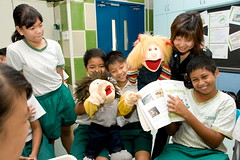Learning Science Through Puppet Play
23 Jun 2009

Students from Mrs Chia-Kay’s Science classes welcome their regular “guests” from the United Kingdom.
Ever had a friend who’s perpetually confused and constantly needs you to lend a helping hand?
Meet Amy!
Once every fortnight, students in Mrs Chia-Kay Cheng Hong’s Pri 5 science class play host to Amy, who comes from the United Kingdom (UK). Whenever Amy pops up, the students know that there is a dilemma to be solved, from choosing the right materials to make a toy to finding the best way to load Amy’s belongings on to a truck.
Yet, despite her muddle-headed ways, the students adore Amy and clamour over whom gets to hug her. With such eager attention, little Amy has to be handled with care. For she is in fact a puppet less than a metre tall!
Puppets lend a hand in teaching science
Amy and her friends, Kim, Benny and Tobi, are puppets that Mrs Chia-Kay whips out to introduce Science concepts in the classroom.
Ever since their debut last July, Amy and her friends have been instant hits at Mrs Chia-Kay’s classes in Casuarina Primary School. But what led her to introduce her pupils to Amy and her animated friends?
The idea was born when Mrs Chia-Kay attended a workshop during a study trip to the UK. “I emerged from the workshop inspired by the use of puppets to encourage pupil interaction and discussions on science and subsequently tried it out on my class,” she said.
In one lesson, Amy puzzled over what materials to use to make a toy that can float on water and move with wind power. To help her, the students put their heads together and came up with various ideas on suitable materials and designs for the toy. As they present their solutions, Amy poses questions to challenge them if they miss the mark and offers encouraging comments if she thinks the students are on the right track.
The next time, when the pupils embark on projects to build their own toys, they do so with Amy’s remarks very much in mind as lessons well learnt and remembered.
Learning with fun instead of fear
With Amy around, the pupils are spontaneous and eager to speak up as they have no fear of getting shot down for a wrong answer.
“Since the students treat the puppets as their pals, there was little inhibition and they responded enthusiastically to the puppets that facilitate the discussion,” explained Mrs Chia-Kay. For teachers who are nursing similar ideas, she suggests that during lessons, the teacher should look at the puppet when it is ‘talking’ so that the pupils focus all their attention on the puppet instead of the teacher.
The pupils appreciate the chance to interact with puppets during Science classes and engage each other with different ideas and resolve them amicably. Says Ziranabila, a Primary 6 pupil, “It helps us learn about science in a more creative way. It’s definitely more interesting than just listening to the teacher all the time.”
Her classmate, Ida Shamira, concurs, “When we use the puppets, we get the chance to discuss our ideas. If we argue about our decisions, we will ask Amy to help us solve the problem.”
Sharing the power of puppets
Thanks to the puppets, the pupils are highly motivated to learn Science and this has translated into better results. “Parents who came to know about this puppet project were very grateful that their children’s interest level in Science has increased,” stated Mrs Chia-Kay.
Other teachers are getting in on the act too. “They were keen to try out this strategy and even wanted to extend its use to other subjects such as English Language and Mother Tongue,” added Mrs Chia-Kay, who has conducted a few sharing sessions on the use of puppets with science teachers in the East 1 cluster.
Now, Mrs Chia-Kay plans to hold more workshops at the Teachers’ Network in June and at the International Science Educators Conference this November. It certainly looks like we can expect more than a handful of puppet action popping up in classrooms in the near future.



